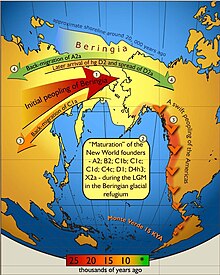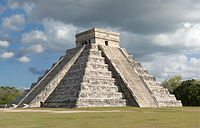Epoka parakolumbiane
Në historinë e Amerikave, epoka para-kolumbiane, e njohur gjithashtu si epoka e para-kontaktit, shtrihet nga popullimi origjinal i Amerikës në Paleolitin e Sipërm deri në kolonizimin evropian, i cili filloi me udhëtimin e Kristofor Kolombit në 1492. Zakonisht, epoka mbulon historinë e kulturave indigjene deri në ndikimin e konsiderueshëm nga evropianët. Kjo mund të ketë ndodhur dekada apo edhe shekuj pas Kolombit për kultura të caktuara.
Shumë qytetërime parakolumbiane u shënuan nga vendbanime të përhershme, qytete, bujqësi, arkitekturë civile dhe monumentale, punime të mëdha tokësore dhe hierarki komplekse shoqërore . Disa nga këto qytetërime ishin zbehur prej kohësh në kohën e kolonive të para të përhershme evropiane ( rreth shekullit te 16-të - fillimi i shekullit të 17-të), [1] dhe njihen vetëm përmes hetimeve arkeologjike dhe historisë gojore . Qytetërime të tjera ishin bashkëkohore me periudhën koloniale dhe u përshkruan në tregimet historike evropiane të asaj kohe. Disa, si qytetërimi Maja, mbanin shënime të shkruara, por për shkak se shumë evropianë të krishterë të asaj kohe i shihnin tekste të tilla si pagane, njerëz si Diego de Landa i dogjën ato, edhe pse kërkonin të ruanin historitë vendase. Vetëm disa dokumente të fshehura kanë mbijetuar në gjuhët e tyre origjinale, ndërsa të tjerët u transkriptuan ose u diktuan në spanjisht, duke u dhënë historianëve modernë pamje të kulturës dhe njohurive të lashta.
Historiografia
[Redakto | Redakto nëpërmjet kodit]Gjenetika
[Redakto | Redakto nëpërmjet kodit]
Haplogrupi që lidhet më shpesh me gjenetikën indigjene është haplogrupi Q1a3a (Y-DNA) . [2] Studiuesit kanë gjetur prova gjenetike që haplogrupi Q1a3a ka qenë në Amerikën e Jugut që të paktën 18,000 pes. [3] Y-ADN, si mtDNA, ndryshon nga kromozomet e tjera bërthamore në atë që shumica e kromozomit Y është unik dhe nuk rikombinohet gjatë mejozës . Kjo ka efektin që modeli historik i mutacioneve mund të studiohet lehtësisht. [4] Modeli tregon se popujt indigjenë përjetuan dy episode gjenetike shumë të dallueshme: së pari me popullsinë fillestare të Amerikës dhe së dyti me kolonizimin evropian të Amerikës . [5] [6] I pari është faktori përcaktues për numrin e linjave të gjeneve dhe haplotipeve themelues të pranishëm në popullatat indigjene të sotme. [6]
Vendbanimi njerëzor i Amerikës ndodhi në faza nga vija bregdetare e Detit Bering, me një qëndrim fillestar 20,000-vjeçar në Beringia për popullsinë themeluese . [7] [8] Diversiteti i mikro-satelitëve dhe shpërndarjet e linjës Y specifike për Amerikën e Jugut tregojnë se disa popullata amerikane kanë qenë të izoluara që nga kolonizimi fillestar i rajonit. [9] Popullatat Na-Dené, Inuite dhe Indigjene e Alaskës shfaqin mutacione të haplogrupit Q-M242 (Y-DNA), megjithatë, dhe janë të dallueshëm nga popujt e tjerë indigjenë me mutacione të ndryshme mtDNA. [10] [11] [12] Kjo sugjeron që migrantët më të hershëm në skajet veriore të Amerikës së Veriut dhe Grenlandës kanë ardhur nga popullsitë e mëvonshme. [13]
Ngulimi i Amerikave
[Redakto | Redakto nëpërmjet kodit]Paleo-indianët nomadë aziatikë mendohet se hynë në Amerikë përmes Urës së Tokës së Beringut (Beringia), tani ngushtica e Beringut, dhe ndoshta përgjatë bregut. Provat gjenetike të gjetura në ADN-në mitokondriale (mtDNA) të trashëguar nga nëna të popujve indigjenë mbështesin teorinë e popullatave të shumta gjenetike që migrojnë nga Azia. [14] [15] [16] Pasi kaluan urën tokësore, ata u zhvendosën drejt jugut përgjatë bregut të Paqësorit [17] dhe përmes një korridori të brendshëm pa akull. [18] Përgjatë mijëvjeçarëve, paleo-indianët u përhapën në të gjithë pjesën tjetër të Amerikës Veriore dhe Jugore.
Pikërisht kur emigruan njerëzit e parë në kontinentin amerikan është temë e shumë debateve. [19] Një nga kulturat më të hershme të identifikueshme ishte kultura Clovis, me vende që datojnë rreth 13,000 vjet më parë. [20] Megjithatë, janë pretenduar vende më të vjetra që datojnë 20,000 vjet më parë. Disa studime gjenetike vlerësojnë se kolonizimi i Amerikës daton midis 40,000 dhe 13,000 vjet më parë. [21] Kronologjia e modeleve të migrimit aktualisht është e ndarë në dy qasje të përgjithshme. E para është teoria e shkurtër e kronologjisë me lëvizjen e parë përtej Alaskës në Amerikë që ndodhi jo më herët se 14,000–17,000 vjet më parë, e ndjekur nga valë të njëpasnjëshme emigrantësh. [22] [23] Besimi i dytë është teoria e gjatë kronologjike, e cila sugjeron se grupi i parë i njerëzve hynë në hemisferë në një datë shumë më të hershme, ndoshta 50,000–40,000 vjet më parë ose më herët. [24] [25] [26]

- ^ "Early European Settlements in North America". Tripline. Marrë më 2017-05-06.
{{cite news}}: Mungon ose është bosh parametri|language=(Ndihmë!) - ^ Bortolini, Maria-Catira; Salzano, Francisco M.; Thomas, Mark G.; etj. (shtator 2003). "Y-Chromosome Evidence for Differing Ancient Demographic Histories in the Americas". American Journal of Human Genetics. 73 (3): 524–539. doi:10.1086/377588. PMC 1180678. PMID 12900798.
{{cite journal}}: Mungon ose është bosh parametri|language=(Ndihmë!) - ^ Sepúlveda, Paz; etj. (2022). "Human Y chromosome sequences from Q Haplogroup reveal a South American settlement pre-18,000 years ago and a profound genomic impact during the Younger Dryas". PLOS ONE. 17 (8): e0271971. Bibcode:2022PLoSO..1771971P. doi:10.1371/journal.pone.0271971. PMC 9385064. PMID 35976870.
{{cite journal}}: Mungon ose është bosh parametri|language=(Ndihmë!) - ^ Orgel, Leslie E. (2004). "Prebiotic chemistry and the origin of the RNA world" (PDF). Critical Reviews in Biochemistry and Molecular Biology. 39 (2): 99–123. CiteSeerX 10.1.1.537.7679. doi:10.1080/10409230490460765. PMID 15217990. Arkivuar (PDF) nga origjinali më 2022-10-09.
{{cite journal}}: Mungon ose është bosh parametri|language=(Ndihmë!) - ^ Wells, Spencer (2002). The Journey of Man: A Genetic Odyssey. Random House. ISBN 978-0-8129-7146-0.
{{cite book}}: Mungon ose është bosh parametri|language=(Ndihmë!) - ^ a b Tymchuk, Wendy (2008). "Learn about Y-DNA Haplogroup Q-M242". Genebase Systems. Arkivuar nga origjinali më 22 qershor 2010.
Haplogroups are defined by unique mutation events such as single nucleotide polymorphisms, or SNPs. These SNPs mark the branch of a haplogroup, and indicate that all descendants of that haplogroup at one time shared a common ancestor. The Y-DNA SNP mutations were passed from father to son over thousands of years. Over time, additional SNPs occur within a haplogroup, leading to new lineages. These new lineages are considered subclades of the haplogroup. Each time a new mutation occurs, there is a new branch in the haplogroup, and therefore a new subclade. Haplogroup Q, possibly the youngest of the 20 Y-chromosome haplogroups, originated with the SNP mutation M242 in a man from Haplogroup P that likely lived in Siberia approximately 15,000 to 20,000 years before present
{{cite web}}: Mungon ose është bosh parametri|language=(Ndihmë!) - ^ Viegas, Jennifer. "First Americans Endured 20,000-Year Layover". Discovery News. Arkivuar nga origjinali më 13 mars 2012.
Archaeological evidence, in fact, recognizes that people started to leave Beringia for the New World around 40,000 years ago, but rapid expansion into North America didn't occur until about 15,000 years ago, when the ice had literally broken
{{cite news}}: Mungon ose është bosh parametri|language=(Ndihmë!) - ^ Than, Ker (2008). "New World Settlers Took 20,000-Year Pit Stop". National Geographic Society. Arkivuar nga origjinali më 19 shkurt 2008.
Over time descendants developed a unique culture—one that was different from the original migrants' way of life in Asia but which contained seeds of the new cultures that would eventually appear throughout the Americas
{{cite news}}: Mungon ose është bosh parametri|language=(Ndihmë!) - ^ "Summary of knowledge on the subclades of Haplogroup Q". Genebase Systems. 2009. Arkivuar nga origjinali më 10 maj 2011. Marrë më 2009-11-22.
{{cite web}}: Mungon ose është bosh parametri|language=(Ndihmë!) - ^ Ruhlen, M. (nëntor 1998). "The origin of the Na-Dene". Proceedings of the National Academy of Sciences of the United States of America. 95 (23): 13994–13996. Bibcode:1998PNAS...9513994R. doi:10.1073/pnas.95.23.13994. PMC 25007. PMID 9811914.
{{cite journal}}: Mungon ose është bosh parametri|language=(Ndihmë!) - ^ Zegura, Stephen L.; Karafet, Tatiana M.; Zhivotovsky, Lev A.; Hammer, Michael F. (janar 2004). "High-resolution SNPs and microsatellite haplotypes point to a single, recent entry of Native American Y chromosomes into the Americas". Molecular Biology and Evolution. 21 (1): 164–175. doi:10.1093/molbev/msh009. PMID 14595095.
{{cite journal}}: Mungon ose është bosh parametri|language=(Ndihmë!) - ^ Saillard, Juliette; Forster, Peter; Lynnerup, Niels; Bandelt, Hans-Jürgen; Nørby, Søren (shtator 2000). "mtDNA Variation among Greenland Eskimos: The Edge of the Beringian Expansion". American Journal of Human Genetics. 67 (3): 718–726. doi:10.1086/303038. PMC 1287530. PMID 10924403.
The relatively lower coalescence time of the entire haplogroup A2 including the shared sub-arctic branches A2b (Siberians and Inuit) and A2a (Eskimos and Na-Dené) is probably due to secondary expansions of haplogroup A2 from the Beringia area, which would have averaged the overall internal variation of haplogroup A2 in North America.
{{cite journal}}: Mungon ose është bosh parametri|language=(Ndihmë!) - ^ Torroni, Antonio; Schurr, Theodore G.; Yang, Chi-Chuan; etj. (janar 1992). "Native American Mitochondrial DNA Analysis Indicates That the Amerind and the Nadene Populations Were Founded by Two Independent Migrations". Genetics. 130 (1): 153–162. doi:10.1093/genetics/130.1.153. PMC 1204788. PMID 1346260.
The divergence time for the Nadene portion of the HaeIII np 663 lineage was about 6,000–10,000 years. Hence, the ancestral Nadene migrated from Asia independently and considerably more recently than the progenitors of the Amerinds.
{{cite journal}}: Mungon ose është bosh parametri|language=(Ndihmë!) - ^ Stinnesbeck, Wolfgang; Becker, Julia; Hering, Fabio; Frey, Eberhard; González, Arturo González; Fohlmeister, Jens; Stinnesbeck, Sarah; Frank, Norbert; Terrazas Mata, Alejandro; Benavente, Martha Elena; Avilés Olguín, Jerónimo; Aceves Núñez, Eugenio; Zell, Patrick; Deininger, Michael (2017-08-30). "The earliest settlers of Mesoamerica date back to the late Pleistocene". PLOS ONE. 12 (8): e0183345. Bibcode:2017PLoSO..1283345S. doi:10.1371/journal.pone.0183345. ISSN 1932-6203. PMC 5576649. PMID 28854194.
{{cite journal}}: Mungon ose është bosh parametri|language=(Ndihmë!) - ^ "Study confirms Bering land bridge flooded later than previously believed". Cyberwest. 31 korrik 1996.
{{cite web}}: Mungon ose është bosh parametri|language=(Ndihmë!) - ^ "Bering Land Bridge National Preserve". National Park System.
{{cite web}}: Mungon ose është bosh parametri|language=(Ndihmë!) - ^ Fladmark, K. R. (janar 1979). "Routes: Alternate Migration Corridors for Early Man in North America". American Antiquity (në anglisht). 44 (1): 55–69. doi:10.2307/279189. ISSN 0002-7316. JSTOR 279189.
- ^ Meltzer, David J. (2009). First peoples in a new world: colonizing ice age America. Berkeley: University of California Press. ISBN 978-0-520-94315-5. OCLC 609850106.
{{cite book}}: Mungon ose është bosh parametri|language=(Ndihmë!) - ^ Stinnesbeck, Wolfgang; Becker, Julia; Hering, Fabio; Frey, Eberhard; González, Arturo González; Fohlmeister, Jens; Stinnesbeck, Sarah; Frank, Norbert; Terrazas Mata, Alejandro; Benavente, Martha Elena; Avilés Olguín, Jerónimo; Aceves Núñez, Eugenio; Zell, Patrick; Deininger, Michael (2017-08-30). "The earliest settlers of Mesoamerica date back to the late Pleistocene". PLOS ONE. 12 (8): e0183345. Bibcode:2017PLoSO..1283345S. doi:10.1371/journal.pone.0183345. ISSN 1932-6203. PMC 5576649. PMID 28854194.
{{cite journal}}: Mungon ose është bosh parametri|language=(Ndihmë!) - ^ Dillehay, Tom D. (2011-03-21). "Early Population Flows In the Western Hemisphere". përmbledhur nga Holloway, Thomas H. (red.). A Companion to Latin American History (në anglisht). John Wiley & Sons. ISBN 978-1-4443-9164-0.
- ^ Wells, Spencer; Read, Mark (2002). The Journey of Man – A Genetic Odyssey. Random House. fq. 138–140. ISBN 0-8129-7146-9.
{{cite book}}: Mungon ose është bosh parametri|language=(Ndihmë!) - ^ Lovgren, Stefan (13 mars 2008). "Americas Settled 15,000 Years Ago, Study Says". National Geographic News. Arkivuar nga origjinali më 14 mars 2008.
{{cite news}}: Mungon ose është bosh parametri|language=(Ndihmë!) - ^ Fagundes, Nelson J.R.; Kanitz, Ricardo; Eckert, Roberta; etj. (2008). "Mitochondrial Population Genomics Supports a Single Pre-Clovis Origin with a Coastal Route for the Peopling of the Americas". American Journal of Human Genetics. 82 (3): 583–592. doi:10.1016/j.ajhg.2007.11.013. PMC 2427228. PMID 18313026.
{{cite journal}}: Mungon ose është bosh parametri|language=(Ndihmë!) - ^ "Atlas of the Human Journey". National Geographic. Arkivuar nga origjinali më 2011-05-01.
{{cite web}}: Mungon ose është bosh parametri|language=(Ndihmë!) - ^ Marder, William (2005). Indians in the Americas: The Untold Story. Book Tree. fq. 11. ISBN 978-1-58509-104-1.
{{cite book}}: Mungon ose është bosh parametri|language=(Ndihmë!) - ^ "Journey of mankind". BradShaw Foundation.
{{cite web}}: Mungon ose është bosh parametri|language=(Ndihmë!)



